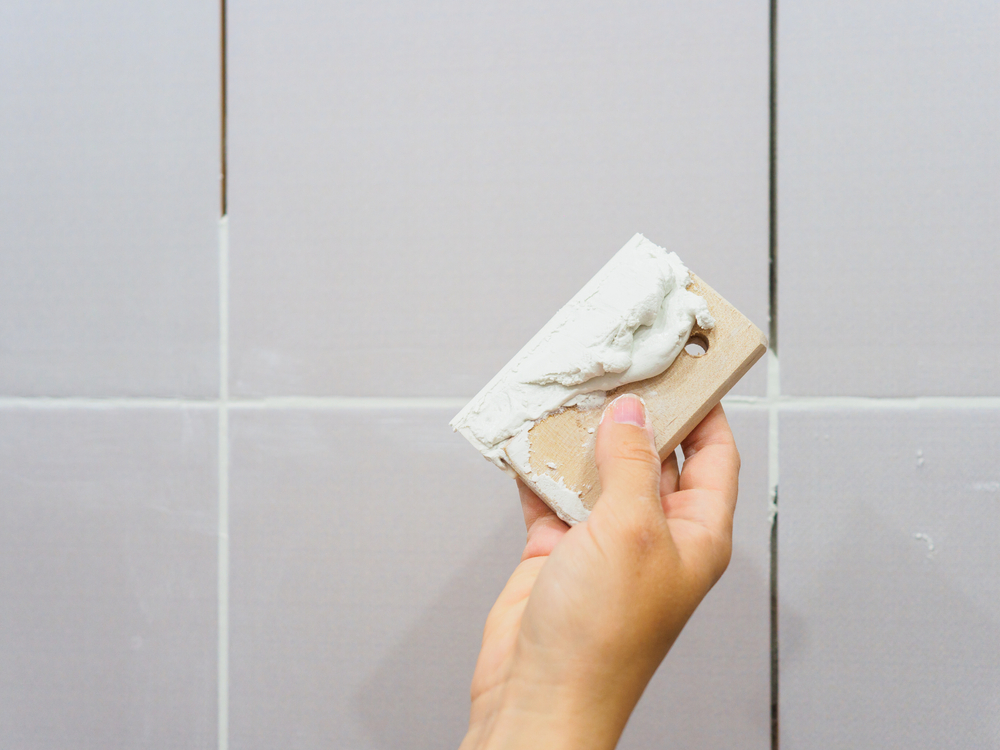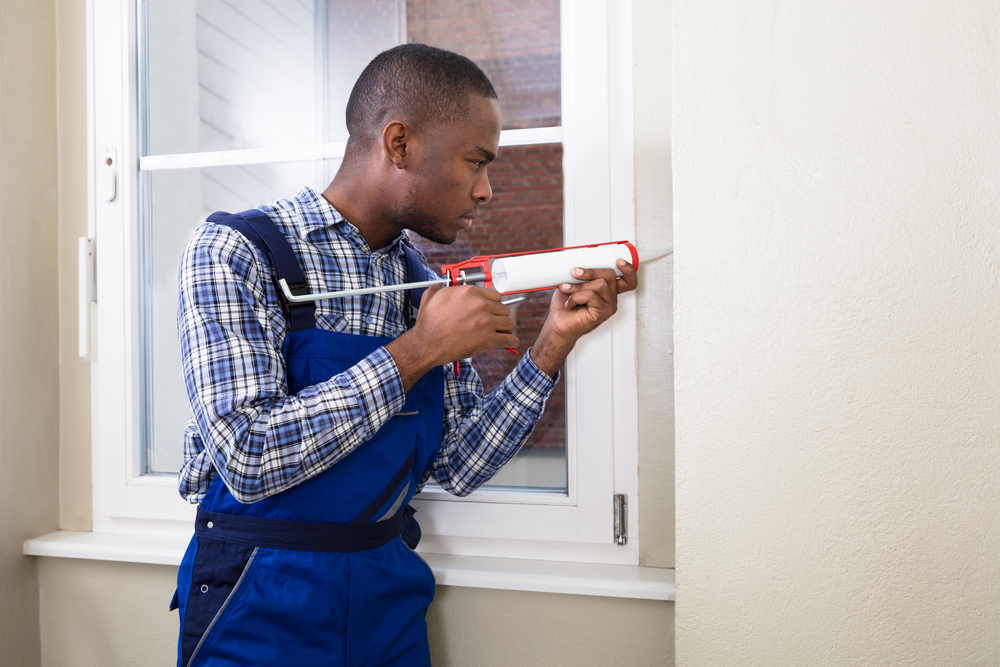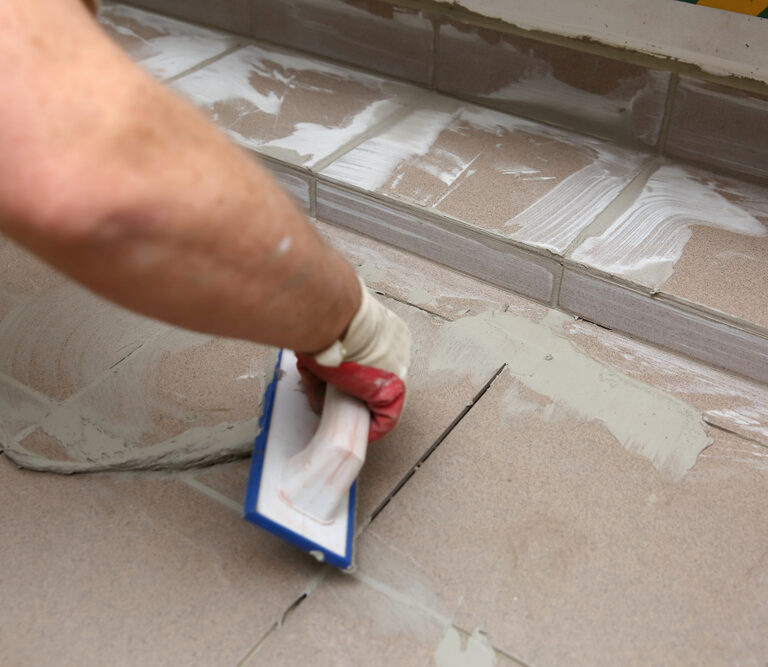Both grout and caulk are popular adhesives used to seal the seams between building materials. While they mostly perform the same job and are applied in more or less the same process, they are not always interchangeable. Because they’re so similar, it’s a common DIY mistake to use them for the wrong jobs or to only use one when you need both.
What you’re sealing will be the biggest deciding factor when choosing between grout vs. caulk but there are a couple other considerations as well. Keep reading to learn what the difference is between grout and caulk and when you should each one.
What Is Grout?

Grout comes in powder form and needs to be mixed with water to make a paste. It’s usually mixture of cement and sand that helps tiles stay in place. Because it’s made of cement and sand, it hardens as it dries but remains porous. As a result, it’s great at keeping tiles in place but not so great at stopping leaks or drafts.
If you were to only apply grout the bathroom floor, you’d soon see mold and stains cropping up in the seams between the tiles.
Where to Use Grout
The main purpose of grout is holding tiles in place. While it performs that task admirably, it doesn’t really do anything else. If you’re not putting tile somewhere, you probably don’t need grout.
With that said, you do need to decide whether you’ll use non-sanded or sanded grout. As you can guess from the names, sanded grout has sand in it and non-sanded grout doesn’t. Here’s how to decide where to use each kind:
Use Non-Sanded Grout for Small or Delicate Jobs
Non-sanded grout is smoother and stickier than its sanded counterpart but it’s also less durable.
Grout Lines Narrower Than Eighth of an Inch
For narrow lines, use non-sanded grout. The smoother texture makes it easier to apply evenly to thin lines. However, it does shrink while drying so you can’t use it on anything wider than an eighth of an inch.
Soft Tiles
For tiles made from a softer material like marble, pearl, or limestone, you should opt for non-sanded grout. Sand is abrasive and could end up scratching the surface your precious tiles while you’re spreading it. Fortunately, the lines between these more delicate tiles tend to be smaller anyway so you usually don’t have to worry about gaps caused by shrinkage.
Vertical Surfaces
When putting tile on a bathroom wall or backsplash, you need an especially tacky grout that won’t glob off while you’re trying to spread it. For that, opt for non-sanded since its stickier and easier to apply to a vertical surface.
It’s safe to use a non-sanded grout on vertical surfaces since they don’t deal with as much wear and tear. You won’t be walking on your walls (unless you have superpowers we don’t know about), so the risk of cracking is much lower.
Use Sanded Grout for Larger Jobs
Sanded grout is messier and more abrasive but it’s also more durable and not as prone to shrinkage or cracks. Use it for wider grout lines, less delicate tile, and flooring:
Grout Lines Narrower Than Eighth of an Inch
For wider grout lines, use a sanded grout. It’s a bit messier to apply but it won’t shrink as much while drying. Non-sanded grout will end up shrinking down and leaving gaps in your grout lines.
Durable Tile
For ceramic or stone tile where scratching isn’t as much of a concern, definitely opt for sanded grout. It’s stronger and better suited to the wider lines you usually have between these kinds of tiles. However, it does stain easily and since the grout lines will probably be wider, that staining will be more noticeable. Make sure to seal your lines to keep staining to a minimum.
Flooring
Unlike walls, floors need the durability and strength of sanded grout because they have to withstand regular foot traffic. The pressure of people walking or of furniture placed on top of tile floors could lead to cracking of non-sanded grout.
Use Epoxy Grout if You Want to Skip Caulk
The general rule with tiling, especially in kitchens and bathrooms, is that you need to apply both grout and caulk. The grout keeps everything in place and the caulk stops water damage and stains.
There is, however, a third path: a relatively new grout made with epoxy and aptly named epoxy grout. It’s waterproof and stain resistant so that you can skip the caulk seal. It also combines the best traits of sanded and non-sanded grout. It’s smooth enough to use on fragile tiles or thin grout lines but durable enough to work in wider lines or on floors.
Because it’s an all-around better material, it’s also a lot more expensive—as in six or seven times the cost of sanded or non-sanded grout. As great as the perks are, most DIYers don’t find them worth the significantly higher price tag. They often choose to just use the classic cement grout and caulking combo.
Another reason DIYers might skip the fancy epoxy grout is because, as you’ll read later in this article, caulk is easier to replace than grout. When the epoxy grout gets old, you need to remove it without damaging the surrounding tile and then reapply new grout, which is a messy affair. Caulk, on the other hand, is comparatively easy to remove and reapply. So, cement grout with a caulk seal is cheaper and has less labor-intensive ongoing maintenance.
Even so, if you’re feeling fancy or you prefer the finished and more natural look of clean grout lines without a caulk seal, epoxy grout is a durable and versatile option.
What Is Caulk?

Caulk comes ready to use right out of the tube. It’s a blend of lots of ingredients but the main one is usually either latex, silicone, polyurethane, or rubber. This formula means that it’s nonporous and able to maintain some flexibility, even when it dries. As a result, caulk is great for waterproofing seams but not great at holding things in place.
If you were to only use caulk on bathroom tiles, the tiles would shift and slide, causing cracks and chips.
Where to Use Caulk
Caulk is best used when you need to make the seams or joints waterproof or when you’re insulating your home. Here are some of the areas where caulk will be a necessity:
In the Kitchen
In your kitchen, caulk should go in the seam between the countertop and the backsplash and along the edges of your sink. If your countertops or floors are tiled, apply a layer of caulk on top of the grout between the tiles.
In the Bathroom
Caulk should be used on just about every seam in the bathroom. Use it between tiles, along the edges of the bathtub and sink, around shower heads and faucets. You should also caulk the seams of baseboards, door trim, and door casing. Being this thorough will prevent water damage from spreading to other areas of your home.
On Windows and Doors
A thin line of caulk around door and window frames is a quick way to insulate your home and reduce energy costs for heating and cooling. If you’re in a dry climate, use a latex formula because it holds up to arid weather better. If you’re in a humid climate, a silicone or polyurethane formula will do better.
For Waterproofing and Fireproofing Your Home
If you’re building a new home or doing a full renovation down to the framing, take that opportunity to apply a caulk seal around your pipes to prevent leaking and around wiring to prevent fire.
In both cases, pay attention to where water or fire damage are likely to occur. Seal the joints on pipes, the seams along electrical conduits, and any other openings that could be vulnerable.
To fireproof your home with caulk, you need to use a special fireproof acrylic caulk, usually called firestop caulk. This formula is designed to expand when it heats up so that it can block passageways and prevent fire from spreading. For smaller fires, it can completely contain the outbreak. For larger fires, it can slow down the spread of flames long enough to be lifesaving.
For Odd Jobs
Caulk is just a good all-purpose material to have on hand for random quick fixes around the house. Some of those odd jobs include:
- Fill in small holes in the wall
- Seal small cracks in tile or walls that aren’t big enough to justify a full renovation
- Reattach wallpaper that’s starting to come away from the wall
- Reattach paneling or molding without having to use nails
- Seal narrow gaps in baseboards and molding
- Seal off cracks and holes that pests are using to get into your home
- Seal small cracks in the roof or reattach shingles when the damage isn’t enough to justify a new roof.
- Revive an aging gutter by touching up cracks or reinforcing joints with a rubber caulk
For bigger projects, like retiling a bathroom or remodeling your kitchen, you’ll likely end up using both grout and caulk. The grout keeps everything in place and the caulk keeps it waterproof, stain-resistant, and insulated. For quick fixes and small repairs, you can probably get away with just caulking. Keep a tube of caulk in your toolbox to have on hand for those odd jobs around the house.
Final Thoughts
When tackling your next project, the grout vs. caulk question is likely to arrive. While both have their benefits, the option you choose depends on your project. Caulk is faster and easier to use, while grout takes more time to work with but yields better results.
